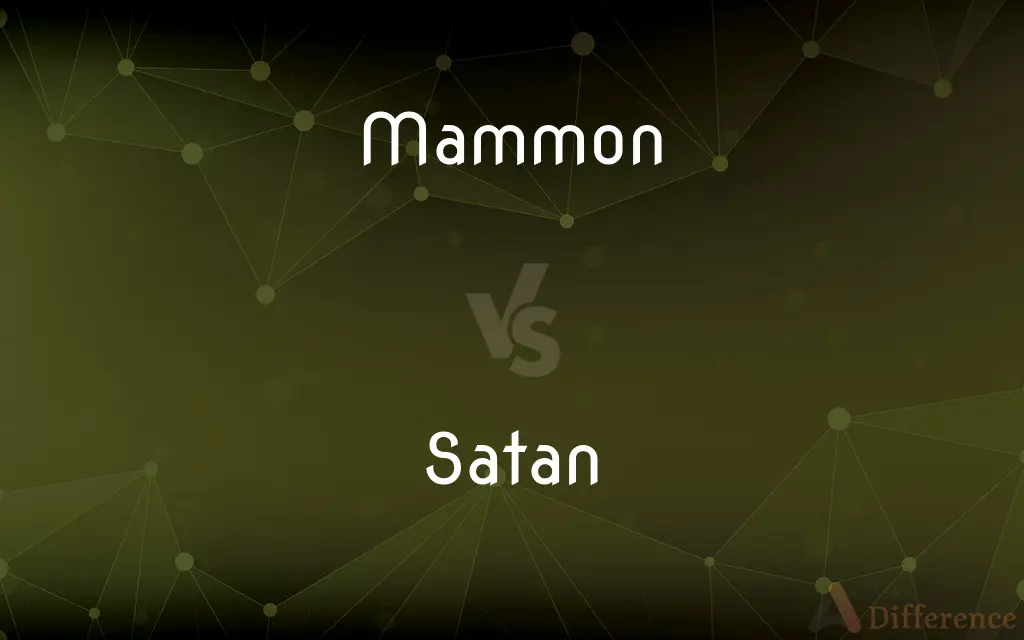Mammon vs. Satan — What's the Difference?
By Maham Liaqat & Urooj Arif — Updated on March 29, 2024
Mammon represents material wealth or greed, often personified as a deity, while Satan is a major figure in Abrahamic religions, embodying evil and temptation.

Difference Between Mammon and Satan
Table of Contents
ADVERTISEMENT
Key Differences
Mammon is often depicted as a symbol or deity of wealth, greed, and materialism, cautioning against the moral and spiritual risks of prioritizing wealth over spiritual values. Satan, on the other hand, is traditionally seen as the embodiment of evil, opposition, and temptation, challenging the faith and morality of humans in various religious texts.
In Christian theology, Mammon is not a fallen angel or a demon in the same sense as Satan, but rather a concept or idol that represents material wealth and greed. Whereas Satan is considered a fallen angel, a direct antagonist to God, embodying rebellion, deceit, and the urge to lead humans away from divine grace.
The concept of Mammon emphasizes the ethical dilemma and spiritual corruption associated with excessive materialism and the pursuit of wealth. In contrast, Satan's role encompasses a broader range of temptations, not limited to material wealth, including pride, lust, and power, aiming to sever the relationship between humans and the divine.
Literary and artistic representations of Mammon often focus on the corrupting power of wealth, portraying Mammon as a warning against the seduction of materialism. Satan, however, has been depicted in a myriad of ways throughout history, from a cunning serpent in the Garden of Eden to a fallen angel lamenting his fate in John Milton's "Paradise Lost," highlighting his multifaceted role as the adversary of both God and humanity.
While Mammon can be considered a part of the many temptations that Satan may use to lead humans astray, the figure of Satan represents the ultimate source of evil and opposition in the cosmic battle between good and evil. Mammon’s domain is more specific, focusing on the dangers of allowing wealth to become an idol that distracts from spiritual and moral paths.
ADVERTISEMENT
Comparison Chart
Representation
Deity or concept of greed and materialism
Embodiment of evil and opposition
Origin
Symbolic, associated with wealth
Fallen angel, adversary of God
Role in Theology
Represents the dangers of materialism
Represents temptation, evil, and rebellion
Literary Depiction
Corrupting power of wealth
Multifaceted, from tempter to fallen angel
Relationship with Humans
Caution against materialism
Temptation towards a broad range of sins
Compare with Definitions
Mammon
Mammon appears in various literary works as a symbol of greed.
Mammon is depicted as a corrupting influence in the narrative.
Satan
Satan is famously known for tempting Eve in the Garden of Eden.
Satan, disguised as a serpent, brought about the fall of man.
Mammon
In literary contexts, Mammon is personified as a deity ruling over material wealth.
In his quest for riches, he worshipped Mammon above all else.
Satan
Satan is a complex character in many literary works.
In Paradise Lost, Satan is portrayed with a mix of rebellion and eloquence.
Mammon
Mammon represents the excessive desire for and pursuit of wealth.
The pursuit of Mammon can lead one to moral bankruptcy.
Satan
Satan is described as an angel who rebelled against God.
Satan, once a favored angel, became the ultimate adversary.
Mammon
Mammon is often used as a metaphor to critique excessive materialism.
Modern society's adoration of Mammon is evident in its consumer culture.
Satan
In religious texts, Satan represents the source of all evil and temptation.
Satan's role is to tempt humans away from righteousness.
Mammon
The concept of Mammon warns against allowing wealth to dominate one's life.
The sermon today focused on the dangers of Mammon.
Satan
Satan symbolizes opposition to divine will.
Satan's existence challenges believers to remain faithful under temptation.
Mammon
Often mammon Material wealth regarded as having an evil influence.
Satan
Alternative form of Satan.
Mammon
Alternative case form of Mammon.
Satan
Satan, also known as the Devil, and sometimes also called Lucifer in Christianity, is a non-physical entity in the Abrahamic religions that seduces humans into sin or falsehood. In Judaism, Satan is seen as an agent subservient to God or typically regarded as a metaphor for the yetzer hara, or "evil inclination".
Mammon
Mammon in the New Testament of the Bible is commonly thought to mean money, material wealth, or any entity that promises wealth, and is associated with the greedy pursuit of gain. The Gospel of Matthew and the Gospel of Luke both quote Jesus using the word in a phrase often rendered in English as "You cannot serve both God and mammon." In the Middle Ages it was often personified and sometimes included in the seven princes of Hell.
Satan
In Abrahamic religions, a powerful spiritual being, the tempter and persecutor of humanity, sometimes considered as an angel who rebelled against God and became the Devil.
Mammon
(Bible) Riches, avarice, and worldly gain personified as a false god in the New Testament.
Satan
The grand adversary of man; the Devil, or Prince of darkness; the chief of the fallen angels; the archfiend.
I beheld Satan as lightning fall from heaven.
Mammon
Riches; wealth; the god of riches; riches, personified.
Ye can not serve God and Mammon.
Satan
(Judeo-Christian and Islamic religions) chief spirit of evil and adversary of God; tempter of mankind; master of Hell
Mammon
Wealth regarded as an evil influence
Mammon
(New Testament) a personification of wealth and avarice as an evil spirit;
Ye cannot serve God and Mammon
Common Curiosities
What does Mammon symbolize?
Mammon symbolizes greed, material wealth, and the moral dangers of prioritizing wealth over spiritual values.
Who is Satan?
Satan is a major figure in Abrahamic religions, often seen as the embodiment of evil, temptation, and rebellion against God.
Are there any positive depictions of Satan?
In some literary works, Satan is depicted with complexity, sometimes evoking sympathy or admiration for his rebellion or eloquence, though these depictions do not change his traditional role as the embodiment of evil.
How do Mammon and Satan relate to each other?
Mammon can be seen as one of the many tools or temptations Satan uses to lead humans astray, focusing on the lure of material wealth.
How is Mammon depicted in art and literature?
Mammon is often depicted as a greedy figure or deity, warning of the corrupting power of wealth.
What is the main difference between Mammon and Satan?
The main difference lies in their roles: Mammon specifically symbolizes the corrupting influence of wealth, while Satan has a broader representation of evil and temptation.
Why is Mammon important in discussions about morality?
Mammon serves as a crucial symbol in discussions about the ethical implications of wealth and the spiritual risks of materialism.
Can the pursuit of wealth always be considered worshiping Mammon?
Not necessarily; it is the excessive and unethical pursuit of wealth at the expense of moral and spiritual values that is considered worshiping Mammon.
Can Mammon be considered a demon?
While not a demon in the traditional sense, Mammon is sometimes personified or represented as a demonic figure symbolizing greed.
Is Mammon worshiped?
In a metaphorical sense, worshiping Mammon refers to the excessive pursuit of and devotion to material wealth over spiritual or ethical considerations.
Does Satan have many names?
Yes, Satan is known by many names across different cultures and religious texts, including Lucifer, the Devil, and the Adversary, each reflecting various aspects of his role.
What makes Satan a central figure in religious teachings?
Satan's role as a tempter and adversary makes him central in illustrating the struggle between good and evil, and the importance of faith and moral integrity.
How do societies view Mammon and Satan today?
In contemporary discourse, Mammon symbolizes the critique of excessive materialism, while Satan represents the embodiment of moral and spiritual opposition.
What lessons can be learned from the concepts of Mammon and Satan?
They teach about the dangers of succumbing to greed and the importance of resisting evil and temptation to maintain spiritual integrity.
Share Your Discovery

Previous Comparison
Calm vs. Serenity
Next Comparison
Antoine vs. AnthonyAuthor Spotlight
Written by
Maham LiaqatCo-written by
Urooj ArifUrooj is a skilled content writer at Ask Difference, known for her exceptional ability to simplify complex topics into engaging and informative content. With a passion for research and a flair for clear, concise writing, she consistently delivers articles that resonate with our diverse audience.














































